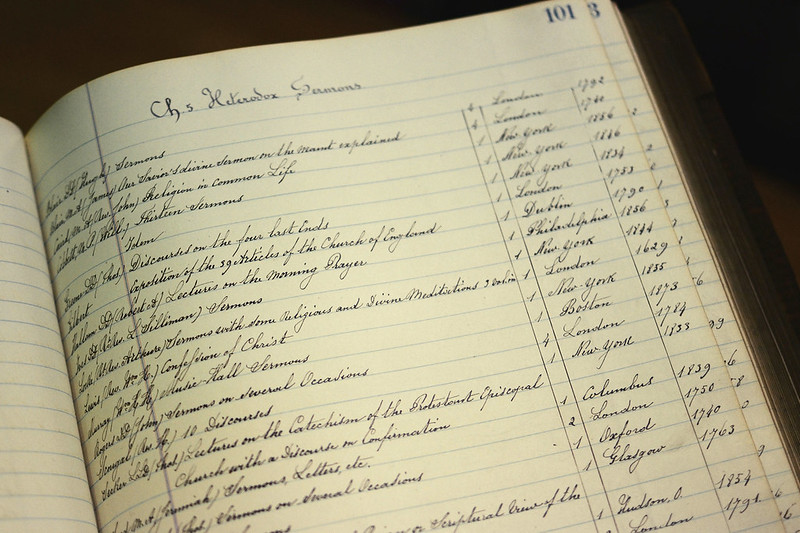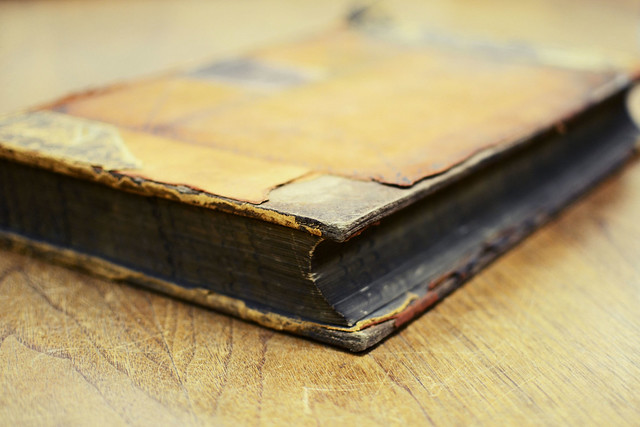The Jesuit Libraries Project
Today I’m thrilled to
share this guest post from Kyle
Roberts, an Assistant Professor of Public History and New Media at Loyola
University in Chicago. Kyle is a historian of evangelicalism in the early
republic whose work focuses on the Atlantic world, the built environment, and
print culture. His forthcoming Evangelical Gotham: Religion and the Making
of New York City, 1783-1860, will rethink
a lot of our assumptions about urban religions and his articles on the
religious history of books have already garnered awards. Before joining Loyola, Kyle worked for
several years in Harvard’s Museum of Natural History and was a postdoctoral
fellow at Queen Mary University London where he helped build a Virtual Library
System of early Protestant library catalogs discussed below. In this post, Kyle
writes his ongoing efforts to collapse the spaces between all of these fields
in his ongoing Jesuit Libraries Project. For Chicagoland readers, the project also comes with an outstanding public seminar series, so take note. And as the conclusion suggests, this is hopefully the first of several
posts from Kyle!
Kyle Roberts
Sometime in the late 1870s, a librarian created a subject
catalogue for the burgeoning library of St Ignatius College, the forerunner to
Loyola University. Founded at the
beginning of that decade on unbroken prairie on the west side of Chicago, St Ignatius
was part of an ambitious, coordinated movement by European-born Jesuits to
found a network of Catholic colleges throughout the upper Midwest. Prospectuses from the college’s early
year tout the dramatic growth of the library’s collection, which numbered over
ten thousand volumes by the end of the decade. The rapid growth of the collection, in fact, likely
necessitated the creation of the catalogue as a finding aid to the expansive
collection. The library catalogue’s
arrangement in six divisions – pantology, theology, legislation, philosophy,
literature, and history – reflected as much the layout of library shelves as it
did the intellectual framework of Jesuit education.
Now, almost one hundred and forty years later, this
manuscript catalogue is providing Loyola graduate students in Loyola’s Digital Humanities,
History,
and Public History
programs a lens into some of the most important tensions within nineteenth-century
urban Catholic identity.
University Archivist
and Curator of Rare Books Kathy Young shared the manuscript catalogue with
me my first week at Loyola. I had
recently arrived in Chicago following a two-year postdoc at Dr Williams’s Centre for
Dissenting Studies, London, where I had helped create Dissenting
Academies Online: Virtual Library System. That database reconstructed the holdings and borrowing
information for leading eighteenth- and nineteenth-century English Baptist,
Congregational, and Presbyterian dissenting academies. By bringing these neglected sources to
light, we hoped to shed new light on the emergence of individual and collective
dissenting identities and their impact on British society and culture. Between the leather boards of the St
Ignatius Library catalogue, I saw the opportunity to reveal through another
innovative digital project the tensions between the Jesuits’ centuries-old
tradition of the Ratio
Studiorum and the demands of a professionalizing urban economy;
between European-born and educated Jesuits and their American-born students,
many the children of immigrants; between the desire for idealism and the
necessity of pragmatism in a rapidly growing city; and between the analog and
the digital in the work of historical inquiry.
Realizing the power of digital platforms to unlock the
secrets of complex analog sources, I immediately began to think of how I might
use the manuscript catalogue as a focus for teaching American religious,
public, and digital history. I
wanted my students to have first-hand experience of the process of building a
collaborative digital humanities project.
Thus began the Jesuit Libraries Project. Undergraduate
interns set to work photographing (and
rephotograhing) the catalogue, transcribing its listings, and seeing if
they could find original books
in the modern library’s stacks.
I applied for a collaborative grant from Loyola’s Hank Center for the Catholic Intellectual
Heritage. While the award from the Hank Center was a small faction of the
funding Dissenting Academies Online received
from the AHRC and the ESRC, it was enough to fund the labor and technical
support costs. My colleagues in Loyola’s Center
for Textual Studies and Digital Humanities saw value in my vision and
enthusiastically agreed to support my efforts. With these pieces in place, I was ready to design a graduate
course that would turn an analog library catalogue into a powerful virtual
library system.
As I sat down to create the syllabus
for the course, I knew I needed to balance discussion of topics related to our
subject matter – book history, Catholic history, urban history, educational
history, public history, and digital history – with time for students to be
trained in the necessary digital applications and to complete their digital
work. With a bumper crop of sixteen
graduate students registered for the course, I was able to divide the 5200+
titles in the original catalogue into manageable segments of around 330 titles each. I told students on the first day of
class that I did not expect them to have any background in the segment on which
they worked. Practitioners in
public history and the digital humanities know full well the reality of working
on projects in which we need to quickly come up to speed on the subject matter
at hand.
I ended up dividing the course into three units. Over the first five weeks of the
semester we will be reading and discussing a variety of contextual topics
related to religious history, urban history, digital history, book history and
bibliography. During this time, students are charged with using Loyola’s online
library catalogue to see how many of the books they have been assigned survive in
the library today.
I knew that during the middle five weeks of the course
students would be working within the virtual library system tracking down MARC
records for the books that have not survived. This can be time-consuming work and I didn’t want to
distract them from it. So, I
decided to use these middle weeks to host a seminar series where I invited leading
scholars of Catholicism and print culture – Ellen Skerrett, Robert Orsi, Jim
Connolly, Tom Tweed, and John McGreevy – to Loyola to share their work through
a lecture or a pre-circulated paper.
To my delight, everyone I asked to participate was intrigued enough by
the project to say yes! The
seminar series is open to the public, so anyone in the Chicago-area that would
like to join us on Tuesday evenings at 6 pm in the Palm
Court at Mundelein Hall, please do! The complete schedule is here. Email me (kroberts2@luc.edu) if you
would like to attend and I’ll send you the paper being discussed.
By the last four weeks of the class, students will have entered
their books into the virtual library system and will focus on thinking about
what their segments of the catalogue have to tell us about our topics of
study. 2014 marks the bicentennial
of the restoration of the Jesuits and Loyola is mounting a major summer exhibition
– Crossings and Dwellings: Restored Jesuits,
Women Religion, American Experience, 1814-2014 (19 July to 19 October
2014) - and an October 2014 conference to
commemorate the event. Each
student will select one surviving book from her or his segment of the catalogue
to have displayed in the exhibition, complete with her or his label text. My hope is that students will continue
to work on the topics that emerge from this class and present papers at the
October 2014 conference.



Comments